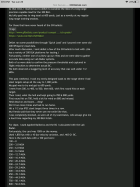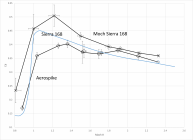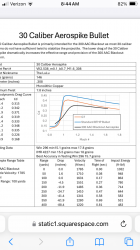OK, here goes.
When I first started I used the Sierra 168 BTHP data from McCoy's book on external ballistics as a reference projectile. Unfortunately, the data didn't match because when you buy the Matchking 168 grain BTHP it appears to have a slightly different ogive then McCoy's data. So what I did was crate a "Moch 168" that had the same shape as the published data out of solid copper for comparison. I then collected data on both the Aerospike Bullet and the Moch Sierra that had almost the exact same weight. The data looks like:
View attachment 1566733
This allowed me to compare the same bullet ogives with the only difference being the base. As you can see, at higher velocities, the two are similar but the Aerospike diverges at around Mach 1.8 and stays lower.
I then used a ballistic simulation to see the comparison between the Moch Sierra, the Published Sierra, and Aerospike. Based upon these simulations, the Aerospike from a 300 Blackout with a MV of 1785 ft/sec (Mach 1.6) would have an effective range out to 600 ft-lbs of impact energy of about 40% longer range than the Moch Sierra (similar nose and weight).
The 30 Cal Aerospike that I have for sale has a Von Kaman ogive that is 2.538 calibers long. This reduces the drag curve even further to give an effective range of 40% further than the plain old Sierra 168 "McCoy's data" but makes the bullet marginally stable out of the .308. Given that most manufacturers won't release their full drag curve, I can't say how my bullets will do against existing bullets without much more testing.
The bullet design was compared to the SAAMI standards for the 300 AAC Blackout to make sure it meets the standard as well as test fired (hundreds of rounds). The bullet has an overall length of 1.314 inches.
I know that it is a risk to try a new bullet. That is why I sell the trial packs so that you can try them without a big investment. If you don't like them, fair enough. I just really love this research and think that these will eventually replace boattails.















